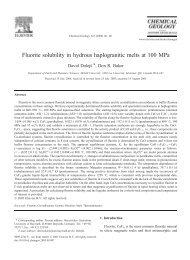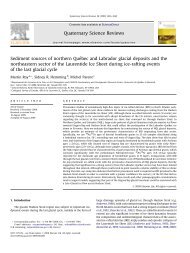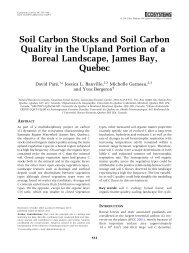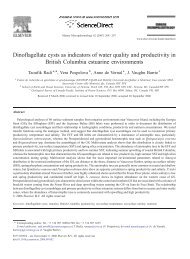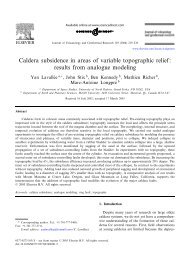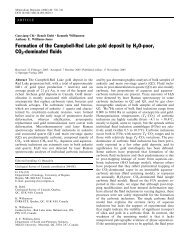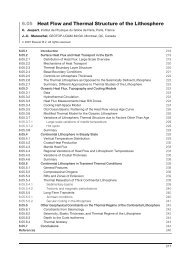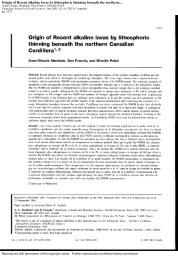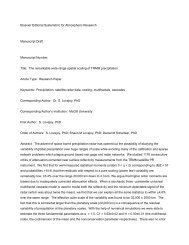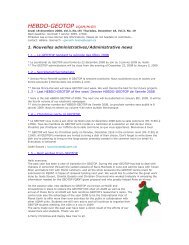Subduction of oceanic lithosphere
Subduction of oceanic lithosphere
Subduction of oceanic lithosphere
You also want an ePaper? Increase the reach of your titles
YUMPU automatically turns print PDFs into web optimized ePapers that Google loves.
<strong>Subduction</strong> <strong>of</strong> <strong>oceanic</strong> <strong>lithosphere</strong><br />
• Evolution <strong>of</strong> the continental crust<br />
• New crust is formed in marginal basins, island arcs, and <strong>oceanic</strong> plateaux<br />
• New crust is accreted to the continents along the active continental margins.<br />
Crust is also added by magmatic underplating<br />
• Continental crust is deformed in collision zones. It is eroded and recycled in<br />
the mantle in subduction zones. Some crust can be subducted in collision<br />
zones.<br />
• What is the budget?<br />
Wednesday, April 14, 2010
• The age <strong>of</strong> continental crust<br />
appears younger at the<br />
margins than at the center<br />
<strong>of</strong> the continent.<br />
• Suggestion by Wilson that<br />
continents grew from a<br />
central core is now<br />
superseded.<br />
• However, new continental<br />
crust has been and is<br />
presently being added at<br />
the active margins, like the<br />
North American Cordillera.<br />
Wednesday, April 14, 2010
<strong>Subduction</strong><br />
• Ocean-Ocean subduction (island<br />
arcs, marginal basins) Western<br />
pacific<br />
• Ocean-Continent subduction.<br />
Eastern Pacific. The Cordilleras <strong>of</strong><br />
N and S America.<br />
• Continental collision. The Alps.<br />
Himalayas.<br />
• Formation <strong>of</strong> future continental<br />
crust<br />
• Accretion <strong>of</strong> new crust by docking<br />
<strong>of</strong> terranes and magmatic<br />
underplating<br />
• Recycling and Destruction <strong>of</strong><br />
continental crust.<br />
Wednesday, April 14, 2010
Location <strong>of</strong> convergent plate margins on Earth. Active back arc<br />
basins are also shown.<br />
Wednesday, April 14, 2010
Wednesday, April 14, 2010<br />
<strong>Subduction</strong> <strong>of</strong> the <strong>oceanic</strong> crust
• The western Pacific contains<br />
most <strong>of</strong> Earth marginal<br />
basins and <strong>oceanic</strong> island<br />
arcs.<br />
• This is where new<br />
continental crust is being<br />
formed<br />
• It will eventually be docked<br />
on the active margins <strong>of</strong> the<br />
continents<br />
Wednesday, April 14, 2010
Wednesday, April 14, 2010<br />
W Pacific. Topography Bathymetry
Wednesday, April 14, 2010<br />
W Pacific Free Air Gravity (from satellite data)
• Tectonic setting <strong>of</strong> Southeast Asia. Thick lines<br />
with closed triangles are modern active trenches<br />
and those with open triangles are inactive. Thick<br />
arrows show the direction <strong>of</strong> plate movement in a<br />
fixed hotspot reference frame after Engebretson et<br />
al. (1985) and Royer and Sandwell (1989). Length<br />
<strong>of</strong> bar is motion for 10 Ma. Spreading centers are<br />
shown in double lines. Thin lines are active<br />
structural boundaries and thin broken lines are<br />
traces <strong>of</strong> <strong>of</strong>fshore or buried structural boundaries.<br />
Abbreviation: T: Trench or Trough, JB: Japan<br />
Basin, NA: Nankai Trough, OT: Okinawa Trough,<br />
DRB: Daito ridges and basins, SB: Shikoku Basin,<br />
OD: Ogasawara Depression, MA: Mariana<br />
Trough, PB: Parece Vela Basin, WPB: West<br />
Philippine Basin, SCB: South China Basin, AB:<br />
Andaman Basin, PA: Palawan Trough, NE:<br />
Negros Trench, SU: Sulu Basin, CO: Cotobato<br />
Trench, CB: Celebes Basin, NS: North Sulawesi<br />
Trench, MB: Makassar Basin, BB: Banda Basin,<br />
MO: Molucca Collision, SO: Sorong Fault, CE:<br />
Ceram Trough, CAB: Caroline Basin, NG: New<br />
Guinea Trench, WE: West Melanesia Trench, NB:<br />
New Britain Trench and TR: Trobriand Trench,<br />
RF: Red River Fault, SF: Seribu Fault.<br />
Wednesday, April 14, 2010
Wednesday, April 14, 2010<br />
Australia: Topography Bathymetry
Wednesday, April 14, 2010<br />
Australia: Free Air Gravity.
Wednesday, April 14, 2010<br />
Scotia Arc: Topography Bathymetry
Wednesday, April 14, 2010<br />
Scotia Arc: Free Air Gravity
Wednesday, April 14, 2010<br />
South America Topography and bathymetry
Wednesday, April 14, 2010<br />
Free Air gravity in the oceans around South America
Wednesday, April 14, 2010<br />
NE Pacific Topography Bathymetry
Wednesday, April 14, 2010<br />
NE Pacific Free Air Gravity
Wednesday, April 14, 2010<br />
Free Air gravity from GRACE (29/10/2004).<br />
Paired gravity anomalies
Wednesday, April 14, 2010<br />
Sea floor age<br />
Note subduction occurs at all ages.
Distribution <strong>of</strong> ages <strong>of</strong> the sea floor<br />
The area <strong>of</strong> Sea floor <strong>of</strong> given<br />
age decreases with age. This<br />
indicates that sea floor is<br />
destroyed at constant rate<br />
regardless <strong>of</strong> age.<br />
Wednesday, April 14, 2010
Oceanic subduction zones<br />
• (top) Schematic section through the upper<br />
140 km <strong>of</strong> a subduction zone, showing the<br />
principal crustal and upper mantle<br />
components and their interactions. Note that<br />
the location <strong>of</strong> the “mantle<br />
wedge” (unlabeled) is that part <strong>of</strong> the<br />
mantle beneath the overriding plate and<br />
between the trench and the most distal part<br />
<strong>of</strong> the arc where subduction-related igneous<br />
or fluid activity is found. MF stands for<br />
magmatic front.<br />
• (bottom) Schematic section through the<br />
center <strong>of</strong> the Earth, which shows better the<br />
scale <strong>of</strong> subduction zones. Subducted<br />
<strong>lithosphere</strong> is shown both penetrating the<br />
660 km discontinuity (right) and stagnating<br />
above the discontinuity (left). A mantle<br />
plume is shown ascending from the site <strong>of</strong><br />
an ancient subducted slab. Dashed box<br />
shows the approximate dimensions <strong>of</strong> the<br />
shallow subduction zone <strong>of</strong> Figure 1b.<br />
Wednesday, April 14, 2010
• Structure <strong>of</strong> the western Pacific subduction zones with a back-arc basin.<br />
Wednesday, April 14, 2010
Semilog scale plotting the depth dimension for subduction zones from 1 km below the surface to the core-mantle<br />
boundary. Mean depth <strong>of</strong> ocean (3880 m) is from Kennett [1982]. Typical crustal thickness (∼20 km) for juvenile<br />
arc crust is from Suyehiro et al. [1996]; crust associated with Andean-type convergent margins may be up to 70<br />
km thick. Mean distance <strong>of</strong> arc volcanoes to trench (166 ± 60 km) and <strong>of</strong> depth beneath arc volcano to seismic<br />
zone (124 ± 38 km) are from Gill [1981]. Greatest depth <strong>of</strong> subducted material returned to surface (∼100 km).<br />
Wednesday, April 14, 2010
Seismic structure, focal mechanisms<br />
• Wadati Beni<strong>of</strong>f zone<br />
• Local seismic tomography<br />
• Stresses in the subducted plate<br />
• Stresses in the overriding plate<br />
• Seismic tomography and the fate <strong>of</strong> the subducted slab.<br />
Wednesday, April 14, 2010
• Plate flexure causes a bulge (outer rise) up from the trench.<br />
Wednesday, April 14, 2010
• The dipping seismogenic zone (Wadati-Beni<strong>of</strong>f zone) delineates the<br />
subducting slab.<br />
• Earthquakes show that the slab is cold and brittle.<br />
Wednesday, April 14, 2010
• Quality factor Q measures<br />
how well energy is<br />
transmitted.<br />
• Attenuation <strong>of</strong> seismic waves<br />
(loss <strong>of</strong> energy) is due to<br />
“friction”, i.e. viscous mantle.<br />
• Comparing seismic signals<br />
that travel through the slab or<br />
below the volcanic arc show<br />
that waves that travel in the<br />
asthenosphere are more<br />
attenuated than waves that<br />
travel through the slab.<br />
• The attenuation affects mostly<br />
the high frequencies that are<br />
attenuated<br />
Wednesday, April 14, 2010
• The Q factor (quality) measures the loss <strong>of</strong> energy <strong>of</strong> the seismic waves. Quality is<br />
high if there is no loss <strong>of</strong> energy. The attenuation <strong>of</strong> seismic waves usually is<br />
caused by partial melting.<br />
Wednesday, April 14, 2010
Velocity anomalies related to temperature<br />
• The subducting plate is seismic because it remains cold and brittle.<br />
The higher velocities are also due to the plate being cold.<br />
Wednesday, April 14, 2010
Wednesday, April 14, 2010<br />
• Tomographic images show that the 650km<br />
discontinuity is a temporary barrier for some plates<br />
that can not penetrate into the lower mantle, but most<br />
eventually do.
• The dip <strong>of</strong> the slab is variable.<br />
• Stresses seem mostly compressive in the shallow dipping slabs otherwise<br />
tensile.<br />
Wednesday, April 14, 2010
• Geophysical images <strong>of</strong> subduction<br />
zones. (a) P wave tomographic image<br />
<strong>of</strong> NE Japan (modified after Zhao et al.<br />
[1994]). There is no vertical<br />
exaggeration. (b) P wave tomographic<br />
image <strong>of</strong> Tonga subduction zone<br />
(modified after Zhao et al. [1997]).<br />
There is no vertical exaggeration. For<br />
both Figures 6a and 6b, red and blue<br />
colors denote regions where the P<br />
wave velocities are relatively slow and<br />
fast, respectively, compared to average<br />
mantle at the same depth. (c) P wave<br />
velocity structure across the Cascadia<br />
<strong>Subduction</strong> Zone (modified after<br />
Parsons et al. [1998]). Yellow dots<br />
show earthquakes during 1970–1996<br />
between 45° and 47° latitude, >M1 at<br />
depths >25 km and >M4 at shallower<br />
depths. Note vertical exaggeration is<br />
2x. Note that the subduction zones in<br />
Figure 6a and 6b subduct old, cold<br />
<strong>lithosphere</strong>, which is relatively easy to<br />
identify tomographically, whereas the<br />
subduction zone in Figure 6c subducts<br />
young <strong>lithosphere</strong>, which differs less in<br />
velocity relative to the surrounding<br />
mantle and is more difficult to image<br />
tomographically. See color version <strong>of</strong><br />
Wednesday, April 14, 2010
Wednesday, April 14, 2010<br />
Mantle structure beneath some subduction zones.
Contrasting tectonic environments in subduction zones.<br />
Extension or compression in the overiding plate<br />
Tectonic variability found behind magmatic<br />
arcs, using the Bolivian Andes and the Lau<br />
Basin as examples. Dark shading denotes<br />
<strong>lithosphere</strong>; underlying white is asthenosphere.<br />
(a) Tectonic setting <strong>of</strong> Lau Basin (modified<br />
after Zhao et al. [1997]), emphasizing<br />
lithospheric structures. Dashed box shows<br />
region <strong>of</strong> detail shown in Figure 20b. (b)<br />
Tectonic setting <strong>of</strong> Andes between 20°S and<br />
24°S (modified after Yuan et al. [2000])<br />
emphasizing crustal structure. Area <strong>of</strong> detail<br />
shown in Figure 20d lies partly within the openended<br />
dashed rectangle. (c) Cross section across<br />
the Lau Basin, emphasizing lithospheric<br />
structure, at the latitude investigated by Ocean<br />
Drilling Progdram Leg (∼20°S) (modified after<br />
Hawkins [1994]). Extension rate is from GPS<br />
measurements <strong>of</strong> Bevis et al. [1995] for<br />
velocities <strong>of</strong> Tonga from Australia; note that the<br />
highest rate is at the northern end <strong>of</strong> Lau Basin<br />
(∼17°S), and the rate decreases to the south. (d)<br />
Cross section across Andean back arc region,<br />
emphasizing crustal structure, about 20°S<br />
(modified after Gubbels et al. [1993]).<br />
Shortening rate is from GPS measurements <strong>of</strong><br />
Bevis et al. [2001]. Figures 20c and 20d have<br />
the same horizontal scale. There is no vertical<br />
exaggeration on any <strong>of</strong> the sections.<br />
Wednesday, April 14, 2010
Wednesday, April 14, 2010<br />
• Compression in the eastern<br />
Pacific.<br />
• Focal mechanisms in the Peruvian<br />
Andes.<br />
• Stress in the overriding plate is<br />
compressive in the Peruvian Andes<br />
where subduction is shallow.<br />
• It suggests that there is crustal<br />
shortening in the overriding plate<br />
in the Andes.
• Deformation in the Peruvian Andes.<br />
• GPS measurement<br />
• Geological rates <strong>of</strong> deformation<br />
Wednesday, April 14, 2010
• Extension in the western<br />
Pacific<br />
• Focal mechanisms show tensile stress<br />
in the overriding plate in the Tonga<br />
Kermadec region.<br />
• Stress consistent with back arc<br />
extension and marginal basin<br />
formation<br />
Wednesday, April 14, 2010
Stress regime determines tectonic style in the overriding plate<br />
• End-member types <strong>of</strong> subduction<br />
zones, based on the buoyancy <strong>of</strong><br />
<strong>lithosphere</strong> being subducted (modified<br />
after Uyeda and Kanamori [1979]).<br />
• Usually young <strong>lithosphere</strong> is buoyant,<br />
but old <strong>lithosphere</strong> could be also be<br />
light if it includes <strong>oceanic</strong> plateaus or<br />
fossil ridges (e.g. Ontong-Java in the<br />
western Pacific, the northern Andes).<br />
Wednesday, April 14, 2010
Back arc spreading<br />
• Several<br />
mechanisms have<br />
been proposed<br />
• Convection<br />
entrained by<br />
subducting plate<br />
and enhanced by<br />
melting<br />
• Slab rollback<br />
(Scotia plate, and<br />
others)<br />
Wednesday, April 14, 2010
Example <strong>of</strong> back arc extension-east Scotia sea<br />
The back arc spreading forms normal<br />
sea floor with well developed marine<br />
magnetic anomalies.<br />
Interpreted magnetic anomaly map <strong>of</strong><br />
the East Scotia Sea. Anomaly<br />
identifications are essentially the same<br />
as those <strong>of</strong> Barker [1995], but recently<br />
identified pseud<strong>of</strong>aults [Livermore et<br />
al., 1994, 1997], formed by ridge<br />
segment propagation [Hey, 1977], are<br />
incorporated in this interpretation. The<br />
central Bruhnes anomaly as well as<br />
anomalies 2A and 3 are shaded. Ridge<br />
crest segments E2–E9 are numbered.<br />
The 2500-m contour (dashed line)<br />
locates the South Sandwich island arc<br />
and the North and South Scotia Ridge.<br />
The ornamented line represents the<br />
trench. The islands identified are<br />
Zavodovski (Z), Candlemas (C),<br />
Montagu (M), and Southern Thule<br />
(ST).<br />
Wednesday, April 14, 2010
Wednesday, April 14, 2010
Back arc extension in the Philippine Basin at the Izu-Bonin trench<br />
Bathymetry Magnetics Gravity<br />
Wednesday, April 14, 2010
Wednesday, April 14, 2010
Wednesday, April 14, 2010
• Free-air gravity anomalies <strong>of</strong> the Ontong Java Plateau–Solomon Islands convergent zone derived from Geosat and ERS-1<br />
altimetry data (Sandwell and Smith, 1997). Arrows indicate direction and rate <strong>of</strong> Pacific plate relative to adjacent plates<br />
from DeMets et al. (1994). Large yellow areas are known or inferred <strong>oceanic</strong> plateaus compiled by C<strong>of</strong>fin and Eldholm<br />
(1994); dashed yellow lines represent hotspot tracks or "tails". Key to abbreviations: NB=Nauru basin; ER=Eauripik Rise;<br />
LP=Louisiade Plateau; OJP=Ontong Java Plateau; VAT=Vanuatu trench; VT=Vitiaz trench; NFP=North Fiji Plateau;<br />
MP=Manihiki Plateau; SHS=Samoa hotspot; TT=Tonga trench; LR=Louisville ridge; HP=Hikurangi Plateau;<br />
THS=Tasminid hotspot; LHS=Lord Howe hotspot. Note the general difficulty in correlating individual hotspot tracks to<br />
<strong>oceanic</strong> plateaus because <strong>of</strong> intervening subduction zones.<br />
Wednesday, April 14, 2010
Evolution <strong>of</strong> the Tonga Fiji subduction?<br />
Tectonic reconstruction <strong>of</strong> the<br />
New Hebrides - Tonga region<br />
(modified and interpreted from<br />
Auzende et al. [1988], Pelletier<br />
et al. [1993], Hathway [1993]<br />
and Schellart et al.(2002a)) at (a)<br />
~ 13 Ma, (b) ~ 9 Ma, (c) 5 Ma<br />
and (d) Present. The Indo-<br />
Australian plate is fixed. DER =<br />
d'Entrcasteaux Ridge, HFZ =<br />
Hunter Fracture Zone, NHT =<br />
New Hebrides Trench, TT =<br />
Tonga Trench, WTP = West<br />
Torres Plateau. Arrows indicate<br />
direction <strong>of</strong> arc migration.<br />
During opening <strong>of</strong> the North Fiji<br />
Basin, the New Hebrides block<br />
has rotated some 40-50°<br />
clockwise [Musgrave and Firth,<br />
1999], while the Fiji Plateau has<br />
rotated some 70-115°<br />
anticlockwise [Malah<strong>of</strong>f et al.,<br />
1982]. During opening <strong>of</strong> the<br />
Lau Basin, the Tonga Ridge has<br />
rotated ~ 20° clockwise [Sager et<br />
al., 1994<br />
Wednesday, April 14, 2010
Volcanic activity in the overriding plate<br />
• Magmatic arc complexities. Only an<br />
idealized section through an<br />
intra<strong>oceanic</strong> arc is shown; similar<br />
processes are expected beneath<br />
Andean-type arcs. Note that the<br />
asthenosphere is shown extending up<br />
to the base <strong>of</strong> the crust; delamination<br />
or negative diapirism is shown, with<br />
blocks <strong>of</strong> the lower crust sinking into<br />
and being abraded by convecting<br />
mantle. Regions where degassing <strong>of</strong><br />
CO2 and H2O is expected are also<br />
shown.<br />
Wednesday, April 14, 2010
• What is the cause <strong>of</strong> the<br />
magmatic activity?<br />
• Simple thermal models show that the<br />
down-going plate remains cold and could<br />
not melt.<br />
• It is likely that melting occurs because<br />
fluids are expelled from the downgoing<br />
slab that lower the melting temperature<br />
in the mantle.<br />
Wednesday, April 14, 2010
Effect <strong>of</strong> water on melting <strong>of</strong><br />
peridotite. (a) Pressuretemperature<br />
diagram for H2O<br />
undersaturated (0.2–0.5 wt %<br />
H2O) and anhydrous partial<br />
melting <strong>of</strong> mid-ocean ridge basalt<br />
(MORB) and pyrolite mantle<br />
composition (modified after<br />
Ulmer [2001]). Dashed lines<br />
indicate the stability limits <strong>of</strong><br />
garnet peridotite (gar), spinel<br />
peridotite (sp), plagioclase<br />
peridotite (plg), and amphibole<br />
peridotite (amph). The dash-dot<br />
line corresponds to the average<br />
curent mantle adiabat (ACMA)<br />
corresponding to a potential<br />
temperature <strong>of</strong> 1280°C. (b) Plot<br />
<strong>of</strong> melt fraction versus<br />
temperatures <strong>of</strong> anhydrous batch<br />
melts <strong>of</strong> a depleted MORB<br />
mantle source at 1.5 GPa with the<br />
liquidus temperatures <strong>of</strong> hydrous<br />
batch melts from peridotite<br />
containing 0.15% H2O and<br />
0.32% <strong>of</strong> simplified Mariana<br />
subduction component, which is<br />
an aqueous fluid with dissolved<br />
solutes [Stolper and Newman,<br />
1994]. Upper axis shows<br />
forsterite content <strong>of</strong> equilibrium<br />
olivine. Figure 13b is from<br />
Gaetani and Grove [1998].<br />
Effect <strong>of</strong> water on the solidus<br />
Wednesday, April 14, 2010
Melting occurs only in a very narrow range. It<br />
determines the location <strong>of</strong> volcanic arc.<br />
• This model accounts for the entrainment <strong>of</strong> the<br />
asthenosphere by the downgoing slab (which<br />
makes it colder at given depth. There is a narrow<br />
window where the geotherm intersects the solidus<br />
for wet mantle.<br />
• (a) Material movement (arrows) and temperature<br />
structure (dashed lines) <strong>of</strong> a simplified convergent<br />
margin (modified after finite element models <strong>of</strong><br />
Davies and Stevenson [1992]). Crust and mantle<br />
<strong>lithosphere</strong> <strong>of</strong> the subducting plate move at a<br />
constant velocity <strong>of</strong> 7 cm yr-1, dragging the<br />
asthenosphere with it beneath the overriding plate.<br />
Note also that the isotherms remain approximately<br />
parallel with the original seafloor, even deep into<br />
the subduction zone. The shaded area in the<br />
mantle wedge approximates the location <strong>of</strong> detail<br />
shown in Figure 12.<br />
• (b) Temperature pr<strong>of</strong>ile beneath the arc volcanoes<br />
(bold line) and melting curve for wet mantle (thin<br />
line). Note that the temperature reaches a<br />
maximum at ∼80 km depth and then decreases as<br />
the subducted <strong>lithosphere</strong> is approached, reaching<br />
a minimum at a depth <strong>of</strong> ∼120 km. The<br />
temperature is high enough for mantle melting<br />
only at a depth <strong>of</strong> ∼80 km, ∼40 km above the<br />
subducted plate.<br />
Wednesday, April 14, 2010
Volcanic Arc<br />
Model for dehydration <strong>of</strong> subducted materials<br />
(modified after Schmidt and Poli [1998]).<br />
Dehydration <strong>of</strong> subducted peridotite and <strong>oceanic</strong><br />
crust occurs continuously to ∼150–200 km; thus<br />
water is continuously supplied to the overlying<br />
mantle. The shaded region in the mantle wedge<br />
labeled “partially molten region” is expected to<br />
melt to a significant degree. The volcanic front<br />
forms where the amount <strong>of</strong> melt can separate and<br />
rise to the surface. Open arrows indicate rise <strong>of</strong><br />
fluid, solid arrows indicate rise <strong>of</strong> melts. Long<br />
arrows indicate flow <strong>of</strong> asthenosphere in the mantle<br />
wedge. Stippled area marks stability field <strong>of</strong><br />
amphibole beneath the forearc. Dashed lines<br />
outline stability fields <strong>of</strong> hydrous phases in<br />
peridotite. The horizontally ruled region shows<br />
where talc is stable. For some thermal structures a<br />
portion <strong>of</strong> the peridotitic <strong>lithosphere</strong> will be<br />
• Detailed cartoon <strong>of</strong> the mantle wedge (region <strong>of</strong> detail<br />
depicted by shading in Figure 11), showing how fluids<br />
might move from the subducted slab into a region where<br />
melts could be generated (modified after Davies and<br />
Stevenson [1992] and Stern [1998]). Water is carried in<br />
the descending slab (A), and dense aqueous fluids are<br />
continuously released from subducted sediments, crust,<br />
and serpentinites (B). These fluids rise into the overlying<br />
mantle to form hydrous phases in mantle peridotite (C).<br />
Amphiboles are shown forming here, but it could also be<br />
another hydrous mineral. Metasomatized mantle<br />
descends with the subducted slab. At the maximum<br />
depth <strong>of</strong> stability for amphibole peridotite, ∼100 km, it<br />
breaks down to anhydrous peridotite and aqueous fluid<br />
(D). The fluid rises vertically, moving away from the<br />
subducted slab and toward hotter regions in the mantle.<br />
At some point the rising water will react with anhydrous<br />
peridotite to form amphibole again (E). This descends<br />
until the amphibole breaks down again (F). Amphibole<br />
peridotite forms (G), descends, and breaks down again<br />
(H). The dark shaded area is mantle that can melt if<br />
sufficient water is provided. Above point H the mantle is<br />
sufficiently hot that water added to it leads to melting (I).<br />
The mantle is still moving downward, so melt will not be<br />
able to rise until enough <strong>of</strong> it accumulates to form a<br />
sufficiently large diapir (K) as a result <strong>of</strong> Rayleigh-<br />
Taylor instability. Partially molten diapirs are less dense<br />
than the surrounding mantle and can rise through it at a<br />
rate <strong>of</strong> perhaps 1 m yr-1 (L). At the base <strong>of</strong> the overlying<br />
mantle <strong>lithosphere</strong> (M), magma separates from the<br />
unmelted part <strong>of</strong> the diapir to feed an arc volcano.<br />
Wednesday, April 14, 2010
• Temporal evolution <strong>of</strong> island arc<br />
magmatism.<br />
• Early stage expulsion <strong>of</strong> water (80-100km)<br />
causes partial melting <strong>of</strong> mantle with<br />
tholeitic magmas.<br />
• At greater depths, the partially molten<br />
region ascents as a diapir and adiabatic<br />
decompression causes more melting and<br />
differentiated calc-alkaline magmas.<br />
Wednesday, April 14, 2010
• Andean style batholiths<br />
• New continental crust is added<br />
directly to the continent through<br />
magmatic activity.<br />
• Sr 87 /Sr 86 indicate mantle origin<br />
with continental crust<br />
contamination.<br />
• Be 10 (1/2 life = 1.5 My) was<br />
found in some <strong>of</strong> the lavas. It<br />
could come only from sediments<br />
that were subducted, melted, and<br />
included in the magmas.<br />
• Note large batholiths in<br />
continents used to detect ancient<br />
Andean type margin (e.g.dePas<br />
batholith in NQO).<br />
Wednesday, April 14, 2010
Proterozoic examples:<br />
Is the elongated de Pas<br />
batholith in the Core Zone<br />
anologuous to the batholith in<br />
the Andes?<br />
Suggests subduction <strong>of</strong> the<br />
Superior plate beneath the core<br />
zone during the NQO<br />
Wednesday, April 14, 2010
Wednesday, April 14, 2010<br />
Wathaman batholith on margin <strong>of</strong> Hearne. No batholith in the<br />
Superior => No subduction beneath Superior during closure <strong>of</strong><br />
Maniwekan ocean?
Wednesday, April 14, 2010<br />
• Andes elevation ~ 6km<br />
• Crustal thickness is<br />
estimated 60-70km<br />
• Crustal thickening by<br />
tectonic shortening and by<br />
magmatic underplating
Wednesday, April 14, 2010<br />
• Receiver function (RF) images and crustal<br />
models <strong>of</strong> the Central Andes along an east–<br />
west pr<strong>of</strong>ile. In the images, red indicates<br />
positive, velocity increase downwards; blue<br />
indicates negative, velocity reduction<br />
downwards. a, Time domain RFs averaged<br />
over a 30-km-wide moving window, 2–10-s<br />
band pass filtered. b, Possible crustal S-wave<br />
velocity (vS) models resulting from the<br />
inversion <strong>of</strong> the RFs in a. c, Interpretative<br />
cartoon with depth-migrated RF image as<br />
background averaged over the Altiplano and<br />
Puna regions. Black plus signs show Moho<br />
depth data from wide-angle reflection<br />
studies4. Local crustal models and a global<br />
mantle reference model were used for<br />
migration. The TRAC1 and TRAC2<br />
converters in a and c border the Andean lowvelocity<br />
zone (ALVZ) which dips westwards<br />
from below the Eastern Cordillera fault<br />
system (indicated in c by black lines at the<br />
surface) across the entire Altiplano/Puna to the<br />
Precordillera (red points at surface indicate<br />
Cenozoic volcanoes). Figure S1 in<br />
Supplementary Information shows this data<br />
set split in two at 23° S for judging north–<br />
south variations <strong>of</strong> the TRAC2 converter.<br />
Figure S2 in Supplementary Information<br />
shows the lateral extension <strong>of</strong> the ALVZ. The<br />
Nazca converter (thick black-white dashed<br />
line indicated in c) is interpreted as an image<br />
<strong>of</strong> the <strong>oceanic</strong> Moho. The upper boundary <strong>of</strong><br />
the <strong>oceanic</strong> crust (slab shear zone) is set<br />
10 km above the <strong>oceanic</strong> Moho in agreement<br />
with the results <strong>of</strong> waveform inversion (see<br />
text and Fig. 4). Oceanic crust is clearly<br />
visible from converted waves only down to
Electrical conductivity <strong>of</strong> the mantle<br />
is measured by MT<br />
Wednesday, April 14, 2010<br />
Contours: depth <strong>of</strong> Nazca plate
Wednesday, April 14, 2010<br />
High conductivity = hydrated mantle
Metamorphism in subduction zones<br />
• Metamorphism in subduction zones<br />
• High pressure in the downgoing slab<br />
• Low pressure in the overiding plate<br />
Wednesday, April 14, 2010
Paired metamorphic belts in Japan<br />
Note paired metamorphic belts are found around the Pacific (with the right polarity)<br />
Wednesday, April 14, 2010
Thermal models <strong>of</strong> end-member (young and hot<br />
versus old and cold) subduction zones. (a) NE Japan<br />
arc, a good example <strong>of</strong> a cold subduction zone. (b)<br />
SW Japan arc, a good example <strong>of</strong> a hot subduction<br />
zone. Note the great difference in the temperature <strong>of</strong><br />
the slab interface at 50 km depth (T50km) and<br />
beneath the volcanic front (Tvf) but the small<br />
difference in the maximum temperature <strong>of</strong> the mantle<br />
wedge beneath the volcanic front (Tmw). (c)<br />
Pressure-temperature diagram showing metamorphic<br />
facies and melting relations for basaltic <strong>oceanic</strong> crust,<br />
along with trajectories for crust subducted beneath<br />
NE and SW Japan Roman numerals identify fields for<br />
metamorphic facies: I, greenschist; II, epidote<br />
amphibolite; III, amphibolite; IV, granulite; V, epidote<br />
blueschist; VI, lawsonite blueschist (green field<br />
shows location <strong>of</strong> the eclogite field, with the dark<br />
dashed line separating this from blueschist); VII,<br />
chloritoid-amphibolite-zoisite eclogite; VIII, zoisitechloritoid<br />
eclogite; and IX, lawsonite-chloritoid<br />
eclogite. Note that <strong>oceanic</strong> crust subducted beneath<br />
SW Japan enters the eclogite field at ~40 km depth<br />
and, if hydrous, begins to melt at ~90 km, whereas<br />
<strong>oceanic</strong> crust subducted beneath NE Japan barely<br />
enters the eclogite field at 120 km depth. Figures 6a–<br />
6c are modified after Peacock and Wang [1999] and<br />
Peacock [2002]. See color version <strong>of</strong> this figure at<br />
back <strong>of</strong> this issue.<br />
Wednesday, April 14, 2010
• The Canadian Cordillera<br />
• Accreted terranes in the Canadian<br />
Cordillera.<br />
• Some terranes are <strong>of</strong> North<br />
American affinity<br />
• Others are <strong>of</strong> <strong>oceanic</strong> affinity.<br />
Wednesday, April 14, 2010
• Main geological belts <strong>of</strong> the<br />
Canadian Cordillera and Bouguer<br />
gravity anomaly.<br />
• Intermontane and Coast belts are<br />
accreted terranes.<br />
• Omineca and Foreland belts are <strong>of</strong><br />
north American affinity.<br />
Wednesday, April 14, 2010
Wednesday, April 14, 2010<br />
Schematic cross section <strong>of</strong> the Canadian Cordillera
Geodynamic model <strong>of</strong> the Canadian Cordillera after the LITHOPROBE studies<br />
• Intermontane belt transported on North America basement.<br />
• Coast belt docked on the side.<br />
• Sediments<br />
Wednesday, April 14, 2010
a, Unmigrated section showing the reflection, labelled JdF, from the top <strong>of</strong> the subducting Juan de Fuca plate west <strong>of</strong><br />
Vancouver Island, the E reflection zone, and the F reflection which marks the top <strong>of</strong> the subducting Juan de Fuca plate further<br />
east. Reflections from the Leech River crustal fault, LRF, are truncated by the E reflections.<br />
b, Migrated section superimposed on a display <strong>of</strong> P wave velocities derived by 3D tomographic inversion <strong>of</strong> first arrivals from<br />
local earthquakes and wide-angle airgun shots around Vancouver Island9. The velocities were extracted from the 3D velocity<br />
model along the composite seismic pr<strong>of</strong>ile shown by the red line in Fig. 1 and projected in the same way as the seismic<br />
reflection data. Earthquakes, which were relocated in the tomographic inversion, are shown by filled black circles. The nearlinear<br />
alignment <strong>of</strong> east-dipping inslab earthquakes just above the <strong>oceanic</strong> Moho at 45–55 km depth may indicate delaminatio<br />
<strong>of</strong> the <strong>oceanic</strong> crust<br />
Wednesday, April 14, 2010
Wednesday, April 14, 2010<br />
• Comparison <strong>of</strong> scattered wave inversion results<br />
with thermal model. a, S-velocity perturbations<br />
below the array, recovered from the inversion <strong>of</strong><br />
scattered waves in the P-wave coda <strong>of</strong> 31<br />
earthquakes recorded at teleseismic distances. The<br />
image represents a bandpass-filtered version <strong>of</strong> the<br />
true perturbations to a one-dimensional, smoothly<br />
varying reference model. Discontinuities are<br />
present where steep changes in perturbation<br />
polarity occur. b, Thermal model <strong>of</strong> Cascadia<br />
subduction zone corresponding approximately to<br />
the pr<strong>of</strong>ile in a. The cool subducting plate<br />
depresses isotherms in the forearc, rendering<br />
serpentine stable within that portion <strong>of</strong> the mantle<br />
encompassed by the dashed rectangle; solid lines<br />
indicate locations <strong>of</strong> subducting <strong>oceanic</strong> crust and<br />
continental Moho. Note temperature contour<br />
interval is 200 °C. c, Interpretation <strong>of</strong> structure in<br />
a. High degrees <strong>of</strong> mantle serpentinization where<br />
the subducting <strong>oceanic</strong> crust enters the forearc<br />
mantle results in an inverted continental Moho<br />
(high-velocity crust on low-velocity mantle),<br />
which gradually reverts eastward to normal<br />
polarity by -122.3° longitude. The signature <strong>of</strong> the<br />
subducting <strong>oceanic</strong> Moho diminishes with depth<br />
as a result <strong>of</strong> progressive eclogitization below<br />
45 km. Inverted triangles in a and c show<br />
instrument locations.
Wednesday, April 14, 2010<br />
What happened to the Farallon plate?<br />
It is still down there!
Wednesday, April 14, 2010<br />
• Cross-section through the Cascadia subduction zone on the northwest coast <strong>of</strong><br />
the United States. Water released from the subducting <strong>oceanic</strong> crust rises up and<br />
hydrates the forearc mantle; water released deeper down causes partial melting<br />
<strong>of</strong> rock to magma that erupts in the arc volcanoes. In the water-altered — or<br />
'serpentinized' — forearc rocks, seismic waves travel more slowly and the usual<br />
gradient <strong>of</strong> wave speed is reversed, producing an effect known as an 'inverted<br />
Moho', which has been detected by Bostock et al.1. The slippery nature <strong>of</strong> the<br />
serpentinized forearc mantle limits the seismogenic depth <strong>of</strong> coupling between<br />
the two plates, and so might also limit the impact <strong>of</strong> earthquakes in the region.
Wednesday, April 14, 2010<br />
• Foreland basins are caused by the bending <strong>of</strong> the plate under<br />
the load <strong>of</strong> the accreted terranes
The accretion <strong>of</strong> terranes over the western margin <strong>of</strong> Canada caused the<br />
formation <strong>of</strong> the Alberta basin<br />
Wednesday, April 14, 2010
Forearc basin-Accretionary prism<br />
End-member forearc types: (a) accretionary<br />
forearc (modified after Dickinson [1995])<br />
and (b) nonaccretionary forearc (P. Fryer,<br />
personal communication, 2001). Note that<br />
the abundance <strong>of</strong> sediments associated with<br />
accretionary forearcs is manifested as an<br />
accretionary prism and as a thick forearc<br />
basin and that the relative lack <strong>of</strong> sediments<br />
leaves the nonaccretionary forearc exposed.<br />
Wednesday, April 14, 2010
Wednesday, April 14, 2010<br />
• Mechanical model <strong>of</strong> an accretionary wedge.<br />
• Balance <strong>of</strong> forces implies a positive slope for the wedge
Erosion and subduction <strong>of</strong> sediment in crust could exceed accretion <strong>of</strong> new<br />
crust.<br />
• Map showing the distribution <strong>of</strong> accreting versus eroding subduction zones<br />
considered within this study. Accretionary margins are shown with solid<br />
barbs on the plate boundary, while open barbs mark erosive margins.<br />
Wednesday, April 14, 2010
Compilation <strong>of</strong> pr<strong>of</strong>iles across<br />
accretionary plate margins. Pr<strong>of</strong>iles are<br />
redrawn and resized to a common scale<br />
in order to allow direct comparison <strong>of</strong><br />
different margins. Sources for the<br />
original data are shown next to each<br />
pr<strong>of</strong>ile.<br />
Wednesday, April 14, 2010
Compilation <strong>of</strong> pr<strong>of</strong>iles across nonaccretionary and erosive plate margins.<br />
Pr<strong>of</strong>iles are redrawn and resized to a common scale in order to allow direct<br />
comparison <strong>of</strong> different margins.<br />
Wednesday, April 14, 2010
Budget <strong>of</strong> all continental margins<br />
Diagram showing the integrated growth<br />
or erosion rate <strong>of</strong> each active plate<br />
margin in relation to the global average<br />
growth rate required to maintain the<br />
continental freeboard. Note that several<br />
erosive plate margins are actively<br />
growing crust despite rapid loss at the<br />
trench.<br />
Wednesday, April 14, 2010
• Pie chart showing the relative proportions<br />
<strong>of</strong> the major inputs and outputs from the<br />
global subduction systems with respect to<br />
the crust. Note the dominance <strong>of</strong> arc<br />
magmatism over subduction accretion as a<br />
source <strong>of</strong> new material.<br />
Wednesday, April 14, 2010
When did subduction processes begin on Earth ?<br />
• Evidence for late Archean subduction?<br />
• Seismic reflector in the mantle interpreted as a relict subducted slab.<br />
Wednesday, April 14, 2010
Mantle reflectors could be fossil<br />
Archean subduction zones.<br />
(example from the Slave Province, LITHOPROBE<br />
SNORCLE transect).<br />
Wednesday, April 14, 2010
Continental crust evolution?<br />
• Today continental crust is being destroyed at about the same rate it is accreted.<br />
• We do not know how the total volume <strong>of</strong> the continental crust has changed with<br />
time.<br />
• Model 4 with a rapid growth <strong>of</strong> the continental crust at the end <strong>of</strong> Archean is<br />
plausible but so are the other models<br />
• Episodic growth models have also been proposed.<br />
Wednesday, April 14, 2010
Summary<br />
• <strong>Subduction</strong> <strong>of</strong> sea floor independent <strong>of</strong> age<br />
• But tectonic style might depend on age <strong>of</strong> the subducted slab (western vs<br />
eastern Pacific)<br />
• Plate remains cold<br />
• Expulsion <strong>of</strong> volatiles causes partial melting in the mantle<br />
• Magmas in volcanic arc from mantle (but …) . Main source <strong>of</strong> continental<br />
growth<br />
• High pressure low temperature metamorphism in subducted slab<br />
• Accretion <strong>of</strong> terranes in North American cordillera<br />
• Plate tectonic and subduction in late Archean at 2.7 Ga<br />
• Budget <strong>of</strong> continental crust?<br />
Wednesday, April 14, 2010
Open questions<br />
• What initiates subduction?<br />
• Mechanism <strong>of</strong> accretion.<br />
• When did present day style <strong>of</strong> subduction start?<br />
• Meaning <strong>of</strong> Archean and Proterozoic subcrustal reflectors.<br />
• What is crustal accretion destruction present budget?<br />
• How did total volume <strong>of</strong> continental crust change with time?<br />
Wednesday, April 14, 2010
• Importance <strong>of</strong> convergence rate and age<br />
<strong>of</strong> subducted <strong>lithosphere</strong>. (a) Plot <strong>of</strong><br />
length <strong>of</strong> seismic zone as a function <strong>of</strong><br />
the product <strong>of</strong> convergence rate and age<br />
<strong>of</strong> subducted <strong>lithosphere</strong>. Approximate<br />
uncertainties are given by error bars.<br />
Dashed line corresponds to length <strong>of</strong><br />
seismic zone equal to convergence rate<br />
multiplied by age divided by 10<br />
(modified after Molnar et al. [1979]).<br />
(b) Plot <strong>of</strong> convergence rate versus<br />
<strong>lithosphere</strong> age, showing the strong<br />
influence this relationship has on<br />
seismicity (modified after Ruff and<br />
Kanamori [1980], using GPS-defined<br />
convergence rates for Pacific-Tonga<br />
[Bevis et al., 1995]. The number at each<br />
subduction zone is the associated<br />
maximum Mw (seismic moment<br />
magnitude), and the contours <strong>of</strong><br />
constant Mw are defined by regression<br />
analysis. Shaded area outlines<br />
subduction zones associated with back<br />
arc spreading or interarc rifting. Note<br />
that most <strong>of</strong> the biggest earthquakes<br />
occur at Andean-type margins.<br />
Wednesday, April 14, 2010
• Diagnostic trace element differences<br />
between adakites and more common<br />
andesite-dacite-rhyolite (ADR) suites<br />
(modified after Defant and Drummond<br />
[1990]). Adakites form by melting at<br />
high pressure in equilibrium with<br />
garnet (garnet has a high partition<br />
coefficient for Y and low partition<br />
coefficients for Sr) and so have low-Y<br />
contents and high Sr/Y. ADR suites<br />
form at lower pressure in equilibrium<br />
with plagioclase (plagioclase has a<br />
high partition coefficient for Sr and<br />
low partition coefficients for Y) and so<br />
have high Y contents and low Sr/Y.<br />
Wednesday, April 14, 2010
Wednesday, April 14, 2010<br />
• Incompatibility plot (spidergram) for important subduction zone inputs<br />
(global subducting sediment (GLOSS) and normal mid-ocean ridge basalt<br />
(NMORB)) and typical outputs (boninite, arc tholeiite, back arc basin<br />
basalt, dacite, and continental crust) from Table 2. Elements on the<br />
horizontal axis are listed in order <strong>of</strong> their incompatibility in the mantle<br />
relative to melt; elements on the left are strongly partitioned into the melt,<br />
whereas those on the right are strongly partitioned into peridotite minerals.<br />
Composition <strong>of</strong> NMORB and element order is after H<strong>of</strong>mann [1988]. Note<br />
the characteristic enrichments <strong>of</strong> GLOSS and subduction zone outputs<br />
relative to MORB with respect to fluid-mobile large-ion lithophile elements:<br />
Rb, Ba, U, K, Pb, and Sr; note the relative depletion <strong>of</strong> these in high field<br />
strength elements: Nb, Ta, Zr, Ti, Y, and heavy rare earth elements. Note<br />
also the greater enrichment and overall similarity <strong>of</strong> the “continental<br />
suite” (GLOSS, continental crust, and Chilean dacite) on the one hand and<br />
the “<strong>oceanic</strong> suite” (boninite, arc tholeiite, back arc basin basalt, and<br />
MORB) on the other. Shaded field encompasses the continental suite.
• Model <strong>of</strong> subducted slabs (modified after Stein and Rubie [1999]). (top) Predicted mineral phase boundaries<br />
and (bottom) resulting buoyancy forces in a downgoing slab with (left) equilibrium mineralogy and (right)<br />
for a nonequilibrium metastable olivine wedge. Assuming equilibrium mineralogy, the slab has significant<br />
negative thermal buoyancy (dark shading in bottom graphs), due to both its colder temperature and the<br />
elevated 410 km discontinuity, and significant positive compositional buoyancy (cross hatching) associated<br />
with the depressed 660 km discontinuity. If a metastable wedge is present, it adds positive buoyancy and<br />
hence decreases the net negative buoyancy force driving subduction. Units are in 103 N m-3.<br />
Wednesday, April 14, 2010
Map <strong>of</strong> Pacific and Caribbean LIP's compared to<br />
modern plate boundaries (yellow lines),<br />
active hotspots/mantle plumes (yellow stars),<br />
and rates <strong>of</strong> the Pacific and Caribbean plate<br />
relative to surrounding plates from global<br />
plate motion model <strong>of</strong> DeMets et al. (1994).<br />
Oceanic plateaus are subdivided into three<br />
tectonic settings as shown in the key to the<br />
upper right. Box denotes Solomon Islands–<br />
Ontong Java Plateau study area for papers in<br />
this volume. Key to abbreviations for larger<br />
LIP's and hotspot tracks: HE=Hawaii–<br />
Emperor seamount chain; SR=Shatsky Rise;<br />
SO=Sea <strong>of</strong> Okhotsk; OP=Ogasawara<br />
Plateau; MNR=Marcus Necker Ridge;<br />
OJP=Ontong Java Plateau; MP=Manihiki<br />
Plateau; HR=Hikurangi Plateau; NR=Nazca<br />
Ridge; CR=Carnegie Ridge; COR=Cocos<br />
Ridge; CP=Caribbean Plateau. Numbered<br />
LIP's 1–21 are keyed to Table 2A (<strong>oceanic</strong><br />
plateau or hotspot tracks presently<br />
subducting at Pacific and Caribbean plate<br />
boundaries) and Table 2B (proposed <strong>oceanic</strong><br />
plateaus accreted during Phanerozoic<br />
collision events involving island arcs or<br />
continental orogenic belts). (B) Schematic<br />
diagram summarizing four possible<br />
relationships between hotspot or mantle<br />
plume heads and hotspot tracks or "tails" in<br />
intraplate (1), subduction (2, 3) and in<br />
ancient orogenic belts (4). See text for<br />
discussion.<br />
Wednesday, April 14, 2010
• Potassium-silica diagram for representative arcs.<br />
Dashed line defines boundary between shoshonitic<br />
and calc-alkaline and tholeiitic suites (CATS). Izu-<br />
Bonin and Mariana arcs are exemplary <strong>of</strong><br />
intra<strong>oceanic</strong> arcs (fields from Stern et al. [2002],<br />
note that volumetrically subordinate Mariana<br />
shoshonites [Sun and Stern, 2001] are omitted).<br />
Field for Andes, 16°S–26°S encompasses most <strong>of</strong><br />
606 Plio-Pleistocene and younger samples from<br />
the Central Volcanic Zone (CVZ) (G. Wörner,<br />
personal communication, 2002). Abbreviations are<br />
as follows: M, typical MORB from Table 2; B,<br />
back arc basin basalt from Table 2; I, mean<br />
composition <strong>of</strong> Izu-Bonin arc samples; MA, mean<br />
composition <strong>of</strong> Mariana arc samples; CC, bulk<br />
continental crust from Table 2; G, GLOSS from<br />
Table 2; A, mean composition <strong>of</strong> Andes CVZ<br />
lavas; and UC, composition <strong>of</strong> upper continental<br />
crust [from McLennan, 2001]. Dark shading<br />
encompasses mean and typical compositions <strong>of</strong><br />
the “<strong>oceanic</strong> suite” (MORB, back arc basin basalt,<br />
and mean Mariana and Izu-Bonin lavas), and light<br />
shading encompasses mean and typical<br />
compositions <strong>of</strong> the “continental suite” (bulk<br />
continental crust, GLOSS, upper continental crust,<br />
and mean Andean dacite).<br />
Wednesday, April 14, 2010
Seismic tomography <strong>of</strong> two arcs<br />
• Crustal structure <strong>of</strong> typical arcs, based on P<br />
wave velocities. Note vertical exaggeration<br />
is ∼5x.<br />
• (a) Izu arc, 33°N (modified after Suyehiro<br />
et al. [1996]).<br />
• (b) Eastern Aleutian arc (modified after<br />
Holbrook et al. [1999]).<br />
• Note differences in thickness and velocity<br />
structure. We do not have comparable<br />
tomographic images <strong>of</strong> Andean-type arc<br />
crust. See color version <strong>of</strong> this figure at<br />
back <strong>of</strong> this issue.<br />
Wednesday, April 14, 2010
• Comparison <strong>of</strong> pattern <strong>of</strong> deformation<br />
observed in Ontong Java Plateau–Solomon<br />
arc convergent zone with examples <strong>of</strong><br />
Phanerozoic and Precambrian patterns <strong>of</strong><br />
deformation in collision zones. Key to<br />
lithospheric compositions: RED=upper<br />
crustal, mainly igneous rocks;<br />
YELLOW=upper crustal, mainly<br />
sedimentary rocks; gray and BLACK=upper<br />
mantle, mainly ultramafic rocks. (A)<br />
Ontong Java Plateau—initial subduction–<br />
accretion <strong>of</strong> uppermost plateau in western<br />
Malaita accretionary prism (modified from<br />
Rahardiawan et al., 2004). Open dots<br />
represent ISC hypocenters (M>4.0). (B)<br />
Ontong Java Plateau—more advanced<br />
subduction–accretion in eastern Malaita<br />
accretionary prism. (C) Cenozoic Alpine<br />
crustal-scale triangle zone or<br />
"flake" (modified from Oxburgh, 1972);<br />
L=base <strong>of</strong> <strong>lithosphere</strong>; M=subducted Moho.<br />
(D) Precambrian Canadian crustal-scale<br />
triangle zones or "flakes" (modified from<br />
Cook et al., 1998); M2=base <strong>of</strong> Slave<br />
Province mantle. (E) Precambrian African<br />
thrust-imbricated, subduction-related prism<br />
Wednesday, April 14, 2010



